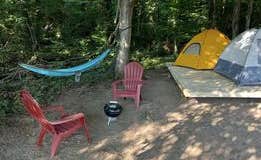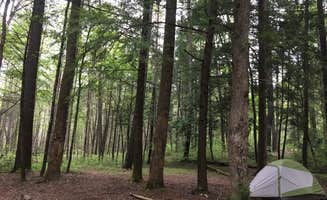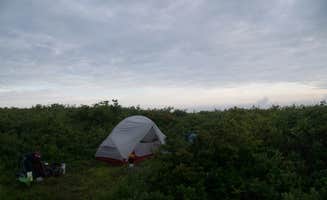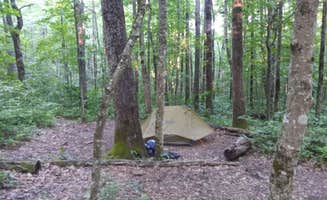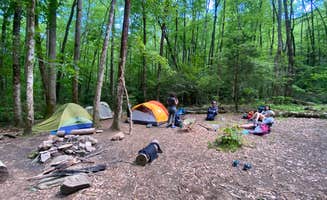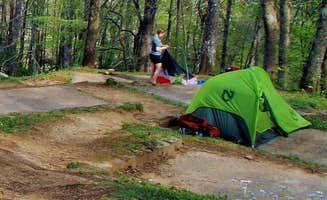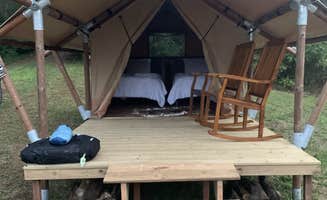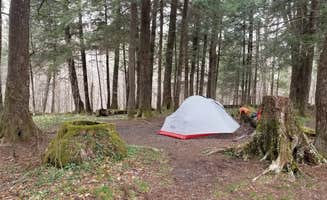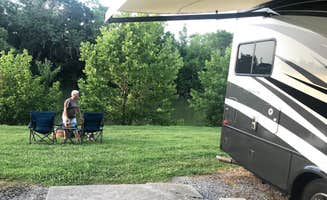Campground Review
On a visit to the Great Smoky Mountains National Park, you quickly learn that you’ll enjoy your visit a lot more if you are located close to what you want to see and do. This means you may find it worth your while to move from one campground to another during your stay, as I did. My final night in the park found me setting up camp at Elkmont Campground, < 5 miles from the Sugarlands entrance, so I would have a shorter drive to view sunset and sunrise from overlooks along the beautiful Newfound Gap Rd. This is also the viewing area for the synchronous fireflies in late May/early June (dates vary; parking passes by lottery in April) if you don’t have a campsite reservation).
Elkmont is open early March – October and reservations are required. If you arrive without a reservation, there is a phone line there that you can call to make them, or you can return to town where you have cell service and make reservations online. This early in the season (mid-April) the campground wasn’t full, some of the loops were closed. I was in site A14, beside a branch of the Little River with a large tent pad, fire ring, picnic table, and paved, slightly sloped, parking pad. It was a compact site; the location of the picnic table between the tent and fire ring made it a challenge to set up a screen house over the picnic table and maintain sufficient distance from the fire. I was pleased with my site and the privacy, though I liked the looks of A13 even better. It was somewhat larger and more secluded. Many of the sites, particularly those on the western side of A - F loops, are along the river. Most of the sites are shaded. A few of the B-loop sites are walk-in. It’s bear country, so your food and toiletries need to be locked in a vehicle or hard-side camping unit; there are some food storage lockers provided for the walk-in sites. There’s a small camp store with limited supplies and hours (open late afternoon); Cades Cove has a much larger one, though it tends more toward souvenirs.
There’s cold running water, flush toilets, and a dishwashing station available, but no showers or hookups (a couple of accessible sites do have electricity for medical equipment). Bathrooms are basic, no frills, but clean; The one in the A loop didn’t even have an outlet or hand dryer. If you ask at the visitor’s center, they’ll provide you with a list of area campgrounds that allow you to take a shower for $3-7. The nearest dump station is a seasonal one at the Sugarlands Visitor Center (doesn’t open until late May); the one at Cades Cove is open year round. Buy firewood in the park or, better yet, pick up deadwood around the park.
One of the more intriguing areas to explore at Elkmont is the Daisy Town ghost town. Once you’ve set up camp, walk or drive down the road toward the Little River and Jakes Creek trails (leaves the camp road to the left before the ranger station on your way into the campground). Follow the signs for additional parking and you’ll find yourself at the end of a road lined with assorted cottages and cabins that used to be vacation homes. Some are open for exploration, others are cordoned off, and some are undergoing renovation. Another nearby, popular highlight is the hike to Laurel Falls.
Product Review
As a Ranger for The Dyrt, I sometimes I get to test and evaluate products. This is a review of a Wenzel Sun Valley 12’ x 12’ Screen House As a camper with a teardrop, I’m always looking to maximize my outdoor living space in subpar conditions, so I was excited to try this out at Elkmont.
I set this up alone the first time in 14 minutes without reading the instructions. The instructions are attached to the inside of the bag and recommend 2 people for set-up, but if you’ve pitched a dome tent in the past, you’ll find this inituitive. Continuous sleeves for 4 of the fiberglass poles and the “Fast Feet” made set- up easy. I did wish the sleeves for the cross-poles were continuous as well, but the gap allows for a hook to hold the ceiling up and it didn’t take much extra effort to slide the poles in. The hardest part was getting the 4th end of the cross poles for the roof into place. I couldn’t bend them enough to slide it in while on the ground, so waited until everything else was up…should have figured it out while it was at ground level rather than over my head! This part would definitely be easier if there were two people pitching it.
The zippers on the two doors close tightly and easily without extreme tension, though it was definitely easier to open and close with 2 hands rather than one. There was no gap at the junction of the 3 zippers. Once you are inside, you have a crystal clear view of the outside! It’s quite tall, I couldn’t touch the ceiling in the middle with a raised hand. It doesn’t have a floor, just a wide border around the perimeter, so you can place it over a picnic table. The picnic table (about 6’) fit inside it easily with plenty of room to walk around and even add a chair in a corner. I had to be careful about making sure the bottom of the walls lay flat on the ground, otherwise there were gaps.
It comes with 10 thin metal stakes for the feet and 4 plastic ones for the guy lines. A word of advice: USE THEM. The first time I set this up, this experienced camper made a rookie mistake. The weather was nice, but it was getting dark, and I wanted to move it over the picnic table in the morning…so I didn’t stake it down. That night a wind storm blew through and blew it away! Found it at 4am in the next campsite, astonished to discover it was still intact! No broken poles, just a slight abrasion on one sleeve and a tiny tear in one part of the screen that will be easily repaired. A couple of the poles slid out of the Fast Feet during its overnight adventure, allowing the screen house to collapse and preventing damage to the poles themselves (I’ve seen MANY other screen houses/canopies with bent and broken poles from wind). Truly impressed.
Pitched it again the next afternoon with the wind still blowing and as you can see in my video, the screen house was like a kite until I staked it down. Once staked, it stood up well to the wind, though it did cause the bottom edge of the screen house to lift a bit. If bugs are out in that weather (there were wind advisories), they probably deserve a chance for some shelter, too.
Taking it down, it easily fit back in the storage bag, with the zipper extending down one end to open the bag a bit more. Oh, and it weighs so much less than many of the canopies do, coming in around 20# and not requiring a wheeled case to lug it around. If you’re looking for a screen house, this one has a lot going for it!
Black fly season is coming and with the Wenzel Sun Valley Screen House packed, I’m ready! MY fuller video review is here: https://www.youtube.com/watch?v=ealCyAi02HA


